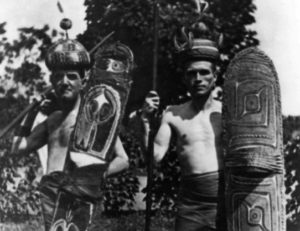
From spent German cartridges to carved crocodiles, Australia’s World War One diggers stationed in New Guinea sent home an eclectic mix of military souvenirs and local artefacts.
A major collection of their war mementos, kept for almost a century in storage in the Museum of Victoria, is the subject of a new book, War Trophies or Curios? The War Museum Collection in Museum Victoria 1915-1920.
Dr Christine Winter, a Matthew Flinders Fellow in History at Flinders University and one of the book’s co-authors, said the Australian and New Zealand troops who in 1914 occupied what was at the time German New Guinea, were keen to let people back home know of their successes, and collected trophies with great enthusiasm.
“During the early part of the war, in a kind of grass roots movement, soldiers collected whatever they could lay their hands on – Mauser pistols, bullets, New Guinean artefacts – and sent these objects home to their towns, villages and rural settlements, where they were exhibited in local shop windows,” Dr Winter said.
“These shop windows were the first transient war memorials in Australia, showing victory and colonial expansion.”
Dr Winter said that as the war dragged on and Australian casualties mounted, the displays honouring “our boys abroad” took on a more sombre and memorial role.
In 1917, the Defence Department called on the Australian military administration in ex-German New Guinea to send war trophies for a future War Museum. Several men responded by sending native weapons and other ‘curios’.
The variety of locations to which these soldiers and officers were posted and their enthusiasm for collecting makes the War Museum collection exquisite in scope and quality.
The collection was uncovered by curators Dr Ron Vanderwal (Melbourne Museum) and Dr Barry Craig (South Australia Museum). Together they identified and catalogued the collection, and developed ‘biographies’ of the objects from their creation and local use, to their collection by military men and their transfer into the museum. In 2012 they secured a Gordon Darling Foundation grant, and invited Dr Winter to be part of the project.
Ironically, Dr Winter said, the collection remained at the Museum of Victoria where they had been temporarily stored because the Australian War Memorial decided the ‘native curios’ were not really ‘war trophies’.
Dr Winter said the rich collection of New Guinea artefacts held in Melbourne, which includes weapons, domestic items, ornaments, ritual masks and elaborate religious carvings, constitutes a significant ethnographic and historical resource.
His Excellency, the Papua New Guinea High Commissioner to Australia, Charles Lepani, who launched the book on 18 April, pointed out the importance of the objects for Papua New Guineans, as part of a their vibrant cultural heritage and for the close and engaged relationship of Papua New Guinea with Australia.
The memento phenomenon was not confined to Victoria: during the next two years, Dr Craig and Dr Winter will work on the collections that were obtained from members of the Australian Naval and Military Expeditionary Forces by the SA Museum, under the project title Tinker, Tailor, Soldier, Sailor…
War Trophies or Curios? The War Museum Collection in the Melbourne Museum, 1950 – 1920 by Barry Craig, Ron Vanderwal and Christine Winter (Museum Victoria Publishing).

